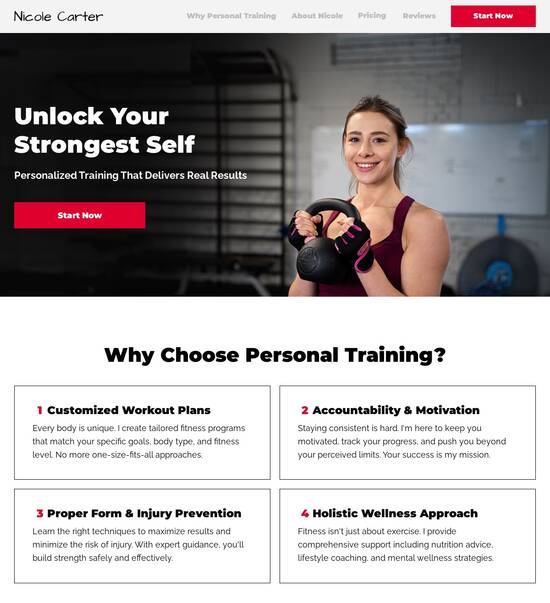
Functional review website template
Explore Similar TemplatesAbout template
Drive more leads with Instapage functional review website template built to maximize conversions. Easy customization - no designer or coding skills needed.
Recommended templates

Easy to build without coding
With the intuitive drag-and-drop builder, anyone on your team can create high-converting pages without any knowledge of code or design. Make enhancements to your landing page with custom widgets using Javascript, HTML/CSS, or third-party scripts.

Multiple layouts for any industry and goal
Select from 500+ landing page layouts built to boost conversions across industry-specific scenarios. Customize them by adjusting fonts, adding images, and generating on-brand content with the AI assistant. Quickly scale with Instablocks® and Global Blocks that you can save, reuse, and update globally.

Loads fast and looks polished on any device
Every template is responsive, which means they present professionally on any device and load blazingly fast with our Thor Render Engine. You can also power them up with Google AMP technology to deliver an unparalleled mobile experience and drive higher conversions.

Robust analytics & experimentation
Get real-time updates and reporting across all your devices, showing the number of visitors, conversions, cost-per-visitor, and cost-per-lead. Launch AI-powered experiments, run A/B tests, and use heatmaps to analyze user behavior, then optimize your landing page to maximize conversions.







Easy to build without coding
With the intuitive drag-and-drop builder, anyone on your team can create high-converting pages without any knowledge of code or design. Make enhancements to your landing page with custom widgets using Javascript, HTML/CSS, or third-party scripts.
Multiple layouts for any industry and goal
Select from 500+ landing page layouts built to boost conversions across industry-specific scenarios. Customize them by adjusting fonts, adding images, and generating on-brand content with the AI assistant. Quickly scale with Instablocks® and Global Blocks that you can save, reuse, and update globally.
Loads fast and looks polished on any device
Every template is responsive, which means they present professionally on any device and load blazingly fast with our Thor Render Engine.
Robust analytics & experimentation
Get real-time updates and reporting across all your devices, showing the number of visitors, conversions, cost-per-visitor, and cost-per-lead. Launch AI-powered experiments, run A/B tests, and use heatmaps to analyze user behavior, then optimize your landing page to maximize conversions.
All the features you need to build functional review template
Explore more featuresLearn how to build top-performing landing pages for any goal
FAQs
Leading the way in building high-performing landing pages





Create high-converting landing pages with Instapage
In the crowded digital marketing landscape, having a powerful landing page can significantly improve the effectiveness of your campaigns. Instapage offers an all-in-one landing page and conversion rate optimization (CRO) platform that enables marketers to streamline their processes and maximize their return on investment (ROI). This guide will take you through a step-by-step approach to creating effective landing pages using Instapage's unique features.
Understanding Instapage's capabilities
Instapage’s robust features encompass everything from customizable templates to detailed analytics. These tools are designed to help you create optimized landing pages, ensuring your marketing efforts yield the highest possible conversions. This section will explore the various functionalities that make Instapage a preferred choice for marketers in verticals like tech, education, and financial services.
- Templates: Access over 100 conversion-focused templates designed to suit any campaign, ensuring faster deployment and improved lead capture.
- A/B testing: Utilize advanced experimentation capabilities to compare different landing pages and refine your approach based on real-time results.
- Personalization: Tailor content and experiences to specific audience segments, enhancing relevance and engagement.
Step 1: Selecting the right template
Choosing the right landing page template is crucial to ensure your campaign's success. Start by analyzing your audience's preferences and behavior. Instapage’s variety of templates can be filtered based on marketing goals and customer needs, allowing for tailored selections.
Step 2: Utilizing lead generation elements
After selecting your template, incorporate pre-built lead generation elements to effectively capture visitor information. This entails adding form fields, buttons, and calls to action.
- Lead forms: Embed customizable forms without having to engage a developer, enabling you to capture essential lead details effortlessly.
- Call-to-action buttons: Strategically place attention-grabbing CTA buttons that guide visitors toward taking defined actions.
- Engagement elements: Include features like countdown timers or interactive elements to encourage user engagement.
Step 3: Analyzing performance for continuous improvement
Once your landing page goes live, it's essential to track its performance rigorously. Instapage's analytics dashboard provides detailed insights into user behavior and page effectiveness.
- Heatmaps: Utilize heatmap features to visualize on-page behavior, helping you understand where users click and how they navigate.
- Conversion metrics: Monitor key performance indicators to identify strengths and weaknesses in your landing page strategy.
- A/B test results: Analyze outcomes from A/B testing to determine which variations drive higher conversions, leading to ongoing improvements.
Each of these steps forms a crucial component of an efficient strategy for creating high-converting landing pages. Instapage is uniquely positioned to help you tackle these components with ease.
Ready to elevate your digital marketing campaigns? Start using Instapage today to discover how easy it is to create effective landing pages that convert.
People also ask about Functional review website template
Functional review website template: A guide for effective implementation
Understanding the functional review website template
Functional review website templates are specialized frameworks designed to facilitate online reviews and ratings for products and services. Their primary purpose is to streamline the collection and display of user-generated feedback, making it easier for consumers to make informed decisions based on shared experiences. Unlike traditional website templates that may have general layouts and functions, functional review templates focus on features that enhance the review process.
These templates typically include built-in rating systems, comment sections for user input, and tools for moderation to ensure quality. This specificity sets them apart from more generic templates, which often lack the necessary integrations and functionalities needed for effective review management.
Dedicated functionalities for user reviews and ratings.
User-generated content integration for authenticity.
Real-time feedback and moderation tools.
Importance for businesses
Incorporating a functional review website template can significantly enhance a business's credibility. By providing a platform for authentic customer feedback, businesses can showcase user satisfaction and transparency, which are crucial for building trust among potential clients. As customers increasingly rely on online reviews before making purchasing decisions, having a dedicated space for these testimonials can directly impact sales.
Industries ranging from hospitality and retail to tech and services can benefit from tailored review templates. For example, a restaurant might utilize a functional template to highlight customer dining experiences, while a software company could showcase user reviews on their technological solutions. Such implementations not only attract customers but foster a sense of community around the brand.
Key features of functional review website templates
One major aspect of functional review website templates is their dynamic review systems. These platforms allow for user-generated content, where customers can leave feedback, rate performances, and engage with other users. Integration of these functionalities is vital as they provide potential buyers with real opinions from actual users, contributing to a more informed decision-making process.
Real-time moderation features are also fundamental for maintaining the quality and relevance of reviews. This ensures that inappropriate content can be swiftly addressed, maintaining the integrity of the review section. Rating systems, such as stars or thumbs up/down, enhance usability by providing at-a-glance information that users can quickly understand.
User-generated content for genuine insights.
Real-time moderation capabilities for quality assurance.
Intuitive rating systems including stars and detailed comments.
Customizable layouts
Customizable layouts are another essential feature of functional review templates. They come in various designs to cater to different sectors. Whether a business requires a formal setting for financial services or a more relaxed look for a travel site, templates should offer appropriate styling options to better connect with their target audience.
Layouts can be designed in either grid or list formats, which can impact user interaction. Grid layouts may appeal more to visually-driven industries, while lists could facilitate easier comparisons in others. Ultimately, the flexibility in design helps ensure that a website not only showcases reviews effectively but also aligns with the brand's identity.
Enhanced navigation
Intuitive navigation is critical in any website, but it's especially important for functional review websites as users often sift through numerous reviews. Clear categories and filters help streamline the searching process, enabling users to find what they're looking for without frustration. This can include filters for rating levels, product categories, or even geographical locations.
Incorporating breadcrumbs can also enhance user experience by helping customers understand their browsing path. By allowing them to backtrack easily, breadcrumbs contribute to a more satisfying and efficient navigation experience, encouraging users to explore further.
User-friendly navigation for a seamless experience.
Effective use of categories and filters.
Breadcrumbs enhance navigation and site exploration.
Mobile optimization
With an increasing number of users accessing websites through mobile devices, responsive design is non-negotiable. Effective functional review website templates optimize the viewing experience, ensuring all features are accessible and intuitive, regardless of the device used. Features like swipe functionality and touch-friendly buttons enhance usability on mobile platforms.
Additionally, understanding differences in user experience across devices can inform design decisions. Desktop users might engage more thoroughly, while mobile users often seek quick information. Catering to both needs ensures that a functional review website appeals to all users.
Designing with users in mind
When designing a functional review website, placing users at the center of the process is vital. Usability should guide design choices, ensuring that customers can easily navigate the site, enjoy fast load times, and access information without obstacles. Elements such as clear fonts and suitable spacing improve readability, making the review process straightforward and engaging.
Utilizing feedback mechanisms, such as surveys or direct feedback forms, can help refine the design further. This engagement lets businesses adapt to user needs, creating a website that evolves based on user interactions and preferences.
Usability should dictate key design elements.
Load time, readability, and accessibility are essential.
Gathering user feedback drives design improvements.
Tailoring to target audiences
Understanding target demographics is crucial in customizing the website experience. Each audience may have unique preferences and needs when it comes to viewing and interacting with reviews. Tailoring the design and content to cater to these specific user groups enhances engagement and promotes user satisfaction.
Moreover, cultural considerations must also guide how reviews are presented. What appeals to one demographic may not resonate with another; hence, reflecting cultural nuances in design and content can further engage users, building a connection between the brand and its audience.
Serving the needs of small businesses
Functional review website templates can be a game-changer for small businesses. Many affordable options are available, allowing budget-conscious business owners to establish a robust online presence without significant financial investment. Effectively utilizing these templates enables small businesses to leverage customer feedback, enhance their credibility, and attract potential clients.
Furthermore, local SEO is essential, and implementing templates that encourage search engine visibility will play a crucial role in driving traffic. Visitors searching for specific services or products will often rely on reviews, making it paramount for small businesses to feature these prominently.
Cost-effective solutions for small business owners.
Importance of local SEO in review management.
Built-in features that resonate with the target audience.
Building a community around reviews
Creating a community around user reviews strengthens relationships between brands and customers. Engaging users through contests, forums, or loyalty programs can encourage repeat feedback and ongoing interaction. When users feel valued, they are likely to return and share further insights, enhancing the overall user experience.
Additionally, a strong user community builds trust. Customers are more likely to rely on feedback from fellow users rather than solely on the brand’s messaging. As such, focusing on community engagement can lead to higher rates of customer retention and satisfaction.
Navigating the reviews and ratings landscape
Establishing clear criteria for evaluating services is essential for a functional review website. Parameters such as relevance, quality, and credibility of the review can influence user perspectives substantially. By outlining these criteria prominently, sites can provide a structured approach that helps maintain the trustworthiness of the reviews featured.
Furthermore, ensuring transparency and authenticity in ratings is vital. This means avoiding manipulated ratings or incentivized reviews, as these can severely damage a business's reputation. Effective techniques for promoting balanced views of reviews include encouraging diverse voices and critiquing both positive and negative experiences.
Clear criteria for evaluating service reviews.
Transparency and authenticity are crucial.
Diverse opinions contribute to a balanced perspective.
Innovating in review presentation
Visual enhancements such as graphs, charts, and infographics can enrich the presentation of user reviews. These visual aids help convey information quickly and effectively, making it easier for users to assimilate feedback. Highlighting standout reviews or testimonials can also guide prospective customers, drawing attention to significant positive experiences.
Moreover, incorporating video content into feedback displays can significantly enhance user engagement. Videos where customers explain their experiences can feel more relatable and authentic, providing a deeper connection and understanding for potential buyers.
The impact of design on user engagement
A well-designed functional review website with visual appeal can greatly influence user engagement. Color schemes and typography play a significant role in creating a welcoming environment. Additionally, using images and multimedia features can enhance the overall presentation, capturing the attention of visitors and encouraging them to explore further.
Different industries may also have distinct design preferences, which can affect user behavior. Researching design trends within specific sectors can help craft a website that meets user expectations and encourages them to interact with reviews more readily.
Visual design affects user engagement significantly.
Aesthetic elements should align with user preferences.
Multimedia can elevate overall user experience.
Creating a cohesive brand identity
Every element of a functional review website should align with the brand's values and messaging. Consistency in design across pages improves user experience and strengthens brand identity. Authentic branding is vital in building trust; when users can identify with the brand's presentation, they are more likely to engage with the content.
Incorporating familiar elements across the website — such as color palette, logo, and typography — reinforces brand recognition, enhancing the overall user interaction experience and heightening customer loyalty.
Continuous improvements and adaptability
For functional review websites to remain effective, constant evolution in line with user needs is crucial. Gathering insights from user interactions helps brands refine their designs. For instance, analytics can reveal which reviews attract the most attention or what design elements create friction in the user experience, enabling timely adjustments.
Additionally, incorporating new technologies and features can provide users with modern functionalities, keeping the website relevant. Adapting to industry trends ensures that a review website can continually deliver value to its users while attracting new visitors.
Adapting design based on user feedback.
Incorporating new technologies keeps the site modern.
Regular updates can enhance overall user satisfaction.
Measuring success through analytics
Assessing the effectiveness of a functional review website template involves carefully choosing key performance indicators (KPIs) to monitor. Tracking metrics such as user engagement rates, bounce rates, and review submission rates help gauge user interest and the template’s overall performance.
Tools available for monitoring user behavior and feedback can significantly aid in refining the user experience. By analyzing the data, businesses can adapt their design and layout to better meet user expectations, ultimately driving higher engagement and satisfaction.
Future trends in functional review website templates
The rise of AI and automation
As technology continues to advance, the integration of AI and automation into functional review website templates may redefine user experiences. One potential benefit lies in automated review moderation, which can reduce the workload on human moderators while ensuring timely responses to user feedback.
Additionally, AI-driven recommendations based on user behavior can provide tailored content that further engages users. Such developments encourage personalized user experiences, making it easier for individuals to find relevant reviews suited to their needs.
Automating moderation processes for efficiency.
AI recommendations can elevate user engagement.
Personalized experiences attract and retain users.
Integrating multiple review channels
The convergence of social media and review websites could play a significant role in the future landscape of feedback mechanics. Brands may need to harness scattered feedback from various channels, integrating them into a cohesive platform that showcases all reviews in one place. This approach not only improves brand reputation but also reflects an understanding of where customers share their opinions.
Strategically managing cross-platform reviews will be critical in shaping business identities. Brands that successfully consolidate feedback will likely gain an advantage in building credibility and trust among their audiences.
Real-world applications and case studies
Successful implementations
A multitude of businesses have successfully implemented functional review website templates, reaping the benefits. For instance, e-commerce platforms that highlight customer reviews tend to observe higher conversion rates and trust from potential buyers. These case studies demonstrate the positive influence of showcasing user feedback on brand success.
Different industries have also found success with review templates. Hospitality businesses that feature guest feedback on their websites often attract more visitors and increase bookings, while tech companies demonstrate the value of customer reviews in their own product developments. Analyzing these successes can guide other businesses looking to implement reviews effectively.
E-commerce benefits significantly from user reviews.
Hospitality industries gain from showcasing guest feedback.
Tech companies utilize reviews for product enhancements.
Strategies for maximizing impact
Businesses should adopt best practices when leveraging review feedback. Actively encouraging satisfied customers to share their experiences can drive more positive reviews, while addressing negative feedback publicly can showcase a commitment to customer satisfaction. These actions help in building a robust user community.
Moreover, campaigns driven by user reviews, such as highlighting customer stories or sharing feedback as part of marketing initiatives, leverage user-generated content for deeper engagement. By developing a solid strategy that integrates reviews seamlessly into brand messaging, companies can build lasting relationships with customers.
Ready to skyrocket conversions?
Supercharge your ad campaigns with high-performing landing pages
Get started














